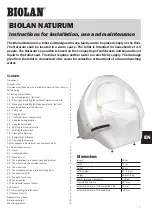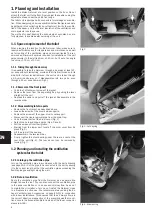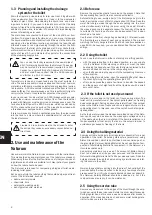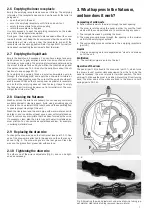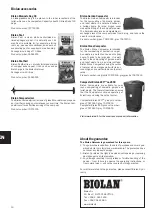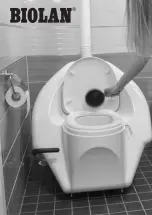
6
2.1 Before use
Remove the protective plastic from around the product. Note that
the separating flap (part 5) is also covered with plastic.
Before starting to use, empty a part of the first charge bag into the
toilet. A suitable amount of first charge is about 20 litres. Dose the
moist first charge mass through the seat opening into the drum
while simultaneously rotating the drum using the pedal. Moisten
the mass in advance in a separate vessel. The humidity of the mass
is suitable if a few drops of water can be squeezed from it when
clenched in the hand.
Use the rest of the first charge bag as bedding; 1 litre/user/week.
The first charge is a blend of peat and compost soil. The product
matching the first charge is Biolan Peat Soil. (see Accessories on
page EN-10) As required, you can use Biolan Peat Soil as the first
charge.
2.2 Using the toilet
You can use the Naturum in either a standing or a sitting position.
• with the separating flap in the closed position, you can urinate
into the Naturum either standing or sitting, or wash the toilet
bowl using the hand shower. This way the liquid is drained to the
sewer and does not end up in the composting drum
• open the flap and drop the paper into the composting drum even
after urination.
• before sitting for defecation, open the separating flap that closes
the drum by turning the operating lever (part 10).
•
after use, depress the pedal a few times to transfer the deposit
and the paper out of sight and flush the liquid bowl with a small
amount of water.
2.3 If the toilet is not used year-round
Installed in a cold space, the toilet can freeze during winter. The
toilet unit is manufactured of frost-proof polyethylene, so freezing
does not damage it. During a period of persistent frost, the compost
mass in the Naturum can freeze and can no longer be turned in the
composting drum. In this case, use of the unit should be temporar-
ily suspended.
As the temperature rises, the mass soon melts and use of the Natu-
rum can be resumed as soon as the mass again collapses on top
of the waste when the drum is rotated. If the liquid is collected in a
tank susceptible to frost, empty the tank in the autumn in order to
avoid damage caused by freezing of the liquid.
2.4 Using the bulking material
Applying suitable bulking material regularly is essential for proper
operation of the toilet. As bulking material we recommend using
Biolan Ground Peat, which is non-fertilised and non-limed peat, or
the granulated Naturum Bulking Material. Do not use Biolan Com-
post and Toilet Bulking Material (or equivalent) in the Naturum, as
it contains coarse bark.
Add bulking material once a week. The amount of Biolan Ground
Peat to be used is one litre per user per week, and the amount of
Naturum Bulking Material is half a litre per week per user. Dose the
bulking material through the seat opening by simultaneously rotat-
ing the drum via the pedal.
Moisten the peat before putting it into the drum. The humidity of the
peat is suitable if, when clenched in the hand, a few drops of water
are squeezed from it. Dry peat repels liquid and does not absorb it.
The Naturum Bulking Material should be added as dry, but if the
compost mass also is dry, it can be moistened.
2.5 Using the service rake
Remove any mass stuck to the edges of the drum through the emp-
tying door, using the service rake. Rotate the drum simultaneously.
During regular use, do this once a week and always after breaks in
operation. If the mass has dried out, add some moist bulking mate-
rial to it while you rotate the drum.
EN
2. Use and maintenance of the
Naturum
Use and maintain the Naturum in accordance with the instructions.
This makes the use and maintenance of the toilet more pleasant.
When using the unit for the first few times, verify that your own seat
-
ing distance and habits are suitable for it. Also instruct your guests
on how the toilet should be used.
The Naturum is intended for composting all types of toilet waste,
including toilet paper.
But do not put into the toilet anything that could hamper post-treat-
ment of the toilet waste, such as:
•
debris, sanitary towels
•
chemicals, lime
•
detergents, washing water
•
ash, cigarette butts, matches
1.3 Planning and installing the drainage
system for the toilet
Drain the liquid in a closed tank for later use, treat it together with
other wastewater from the property, or take it to the wastewater
treatment plant. When dimensioning the liquid tank and decid-
ing where to locate it, you need to take into account that the daily
amount of liquid from the separating toilet is 1-1,5 litres per user. In
addition to plain urine, take also into account in dimensioning the
amount of washing water used.
The drain hose is connected to the rear of the unit at 8.5 cm from
the floor. The drain hose is flexible, so you can move it sideways.
The liquid must flow without obstruction all the way to the drain. De
-
pending on the installation location, accomplish the lead-through
either as a sewer, or as a pipe leading through the wall or the floor.
The diameter of the toilet unit’s drain hose is 32 mm. Route the liq-
uid forward from the unit through a pipe joined up from sewer pipe
parts of at least 50 cm in diameter. Buy parts for the connections
at the plumbing supply store.
You can use the facility reserved for the sewer pipe of
a WC for draining liquids from the Naturum. The sewer
may be located as recommended/required for a WC.
Connect an angular fitting of 90 degrees to Naturum'
s 32-mm drain hose, connect this to a 32-50 reducer,
and further to a 50-110 reducer.
Typical slurry tanks and closed tanks are the most suitable for
urine. These are available in various sizes and their most common
material is rotationally moulded polyethylene or glass-fibre (polyes
-
ter) laminate. A 30-litre canister located under the floor is in most
cases sufficient for summerhouses, as this is sufficiently light to
carry into the forest or to spread its contents on the plants.
In year-round use, 3 cubic metres, i.e. 3000 litres should be consid-
ered as the minimum volume for a family of four. Then the tank that
is used with Naturum must be emptied on average once a year. The
tank should be fitted with a Ø200 mm pipe, which is extended by
50-70 cm above the ground surface. The pipe shall be closed with
a threaded cover equipped with a rubber gasket.
It is recommended to branch a ventilation pipe from the pipe routed
into the tank to a place, where the possible smell of urine causes
the least nuisance.
Liquids rich in nutrients must not be allowed to enter
the soil as they cause an excessively concentrated nu-
trient load.



